综述:关于游戏内弹窗提示和通知类运用的相关整合分析
偏正面分析:
篇目1,Evan Fradley-Pereira关于通知推送的六个建议
1.了解如何以及何时征求许可
所有游戏在发送推送通知前都需要得到玩家的许可。当用户同意请求时,他们将提供一个标记让游戏能够在之后联系玩家。只有少数游戏能够有效地安排推送请求的时间。大多数游戏都是在第一个回合的一开始便发出推送,而那时候玩家对于游戏的了解仅限于名字,标记,以及他们在应用商店里看到的游戏描述。一些活跃的玩家可能会不断接收到这些请求,而大多数情况下这都不是很好的体验。许多发行商会使用鸟枪式方法去传达通知,而这么做不仅会破坏游戏体验,同时还会导致整款游戏将只能依赖于通知去与玩家进行交流。
所以该如何做呢?发行商应该在询问前耐心等待,直至玩家有机会开始玩你的游戏,并将这种请求与背景相融合,如此玩家便能够清楚他们所面对的是什么内容。
《过马路》在这方面便做得很好。比起一开始便请求许可,他们耐心地等待着玩家有机会通过接收免费礼物而获得打开全新角色的乐趣。一旦玩家打开他们的第二个角色,游戏便会询问他们是否愿意在下一个礼物出现前得到提醒。如此玩家便会清楚他们在获得下一个乐趣前能够得到通知,并因此作出自己的决定。
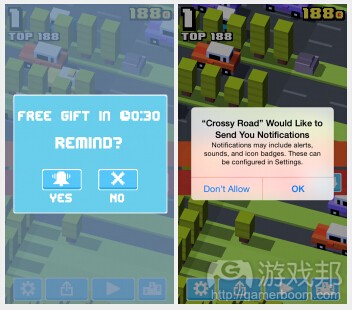
notification(from gamasutra)
2.着眼于细节
从一开始便认真思考为什么你要接触玩家并决定当他们收到通知时你希望他们做些什么。你是否希望他们能够完成购买?是否存在你希望他们参与的特定机制?考虑清楚这些问题的答案将帮助你衡量你的推广的效能并进一步写出有效的副本。
3.了解你的用户
当提到运行有效的推广活动时,明确划分玩家基础是成功的一半。如果你能够肯定自己是在与适当的玩家谈论适当的请求,那么你的活动成功性便会更大。
不要向非转换型玩家发送50美元应用内部购买的信息。不可能所有玩家的第一次IAP都如此高价,这也表示你缺少对他们的游戏风格的理解。同时,不要向鲸鱼玩家推广那些对他们没什么用处的小型IAP折扣。随着时间的发展,这些无意义的骚扰都有可能导致玩家对你的游戏通知产生排斥感。
4.把握适当的时机
为了尽可能地获得更多关注,你需要谨慎考虑发送推送通知的时间。通常情况下在工作日的午后以及周末的夜晚是玩家最活跃的时间,但你也要通过观察分析去判断哪个时间段最适合你的玩家。面向更年轻的用户的游戏的活跃时间通常是在下午3点至5点,即放学回家的路上。这么做能够确保你的玩家刚好在玩游戏的时候收到你的推送通知。
5.最简洁的表达
推送通知最好保持在110个字符,或者大概4行文本,并保证将最重要的细节内容写在前面。保持通知足够简单能够让玩家在关注着其它事物的同时也能够轻松理解内容。较长的通知内容有可能不能有效传达信息并且可能导致玩家难以集中精神。
6.提供细节
就像我在之前的一篇文章中提到的,完成了IAP的玩家只是那些会留意选择的玩家中的一部分。在意识与完成之间,玩家需要估算你所提供的内容对自己是否有价值。所以你的推送通知将能够帮助他们做出判断。
“快回来!我们将提供给你很棒的内容!”
像这样的推送通知并不能提供给玩家直接评估内容的必要信息。这只是在引诱他们回到游戏中,但却未能给予他们相关细节,如果玩家最终未能获得自己想要的内容便会觉得这是在浪费自己的时间。
相反地你应该提供给玩家包含细节的推送通知,如:
“仅在本周大包货币将享有50%的折扣!快来买吧!”
这能够提供给玩家他们在决定自己是否想要你所提供的内容时所需要的一切细节。也许这会太直接,但如果你能够有效划分玩家并将该通知发送给适当的玩家,那便再合适不过了。
明确的推送通知是我们在Fuse所提供的工具之一,这也是我们努力完成Player-Centric Platform的一部分。我们的目标是通过提供给所有玩家最佳体验而帮助我们的合作商们获得最大的利益。
篇目2,Thais Weiller谈通知类推送在手游中的效能
有时候我会梦到自己在做一些日常琐事,如煎蛋。但是有时候在这些梦中,当我像在现实生活中那样做着这些事时,却会出现意想不到的结果,而我也不知道是哪一环出现了问题。你是否也遇到过类似的情境?我敢肯定你们至少遇到过一次这种情况。就像对于我来说,本来在梦中好端端地煎着鸡蛋,但是突然鸡蛋就变成了一只多彩的小鸟,而我则是在虐待着这只可怜的小动物并因此遭到逮捕。
我怎么会知道鸡蛋是一只小鸟?它明明就与现实中的鸡蛋无异。结果便证明我们潜意识里其实是一个非常糟糕的游戏设计师,即不能在你做出任何决定前提供准确的信息。这会导致你被自己的想法所欺骗。当然了,这种情况出现在潜意识里并不成问题,因为那时候人们并不能购买新的东西,但是你不能在游戏中呈现出这种效果,因为这会让玩家感觉自己被欺骗了,并会因此转向其它游戏。
反馈是玩家收到有关游戏信息的最有效方法,所以它在游戏中才如此重要。主要存在两种反馈形式,即时反馈和长期反馈。即时反馈主要是受到游戏玩法的驱动,并将帮助玩家理解该执行怎样的行动(攻击或跳跃),不该做什么(掉入悬崖,撞上敌人),以及他自己在游戏中的总体状态。
.jpg)
举个例子来说吧,当马里奥获得一分时,我们便会听到熟悉且欢快的音乐响起,数字也会开始上升,而当他碰到蘑菇一样的生物时(如Goomba),便会响起不是很愉快的声音,并且马里奥也会缩小。玩家便可以从中清楚滴看到自己该争取什么以及避免什么。
《愤怒的小鸟》拥有多个阶段和不同的世界,提供给玩家有关他们游戏进程的反馈以及成就感。
与即时反馈一样重要的是,长期反馈会轻拍玩家的背部说道:“嘿,看看你走了多远!恭喜你!”。经典的游戏通常都会使用变化的环境(游戏邦注:如埃及和火山阶段会告诉玩家“这些阶段是不同的切具有挑战性,说明你在游戏中不断前进着”)以及引进新机制和敌人去“轻拍”玩家。尽管今天也有许多游戏在使用这种方法,但是还有其它更有效的方式能够推动着玩家前进。
《Candy Crush Saga》拥有与《愤怒的小鸟》的阶段相同的功能,并且是基于更有趣的方式进行设计。
有时候你的玩家可能并未待在游戏中,所以我们便需要提供长期反馈。这在手机游戏中很常见,因为玩家在任何时候都可以收到电子邮件通知或任何来自游戏中的内容。在手机上,我们可以使用告示去提醒玩家“我需要回到这款出色的游戏中”,这也是这种方法重要性的体现。但是你并不能只是添加告示但却不去考虑怎样的告示类型最适合你所创造的游戏。
例如,像《迷你大楼》和《D.O.T》等基于现实世界的游戏便会在出现新更新内容的情况下准时通知玩家,但是在此之后便不会多通知其它事宜。《迷你大楼》总是会在玩家离开游戏后通知他们第一层楼需要补给,但却不传达有关之后楼层的内容,而《D.O.T》则会在玩家能量添满时通知他们。这种“只陈述首要事件”的方法真的非常重要,因为如果太频繁地使用通知,玩家便会感到厌烦并可能卸载游戏。
非实时游戏在选择适当的通知内容方面更加困难。如果通知太多错误的内容将会导致应用变成一个垃圾工厂,而过少的通知则会导致游戏被遗忘。在这种情况下我们需要做的便是创造一个能够定期改变游戏玩法或道具的事件安排。举个例子来说吧,每周你的无限奔跑者都拥有一套随机诞生于关卡设计的道具,玩家可以随机收集这些道具,而如果游戏能够在每次出现新道具时通知玩家的话,他们便会很乐意回到游戏中。
当然了,如果你的游戏一开始就非常无聊,那么即使是通知也不可能推动着玩家回到游戏中。所以通知只能说是重要的功能,但却不是万能的。基于准确的判断力并整合游戏环境,通知将能够有效地帮助游戏散发魅力。
篇目3,Matthew Tubergen谈推送的时间点和频率
本文作者是Matthew Tubergen。Matt是手机内容领域的专家,和迪斯尼、NFL和LucasArts有长达10年的合作经验。此外,Matt还主管W3i旗下的发行工作室和投资基金Recharge Studios。
这是令所有游戏玩家恐惧的情境,至少在我们是在刚有时间玩手机的时候。你整天都在参加会议,你感觉手机发出声响,但你没法查看。你因此错失多少邮件、文本和电话?最后你终于有机会浏览手机。在点击几十条提醒通知(游戏邦注:从腐烂作物到第10个“当日交易”)后,你会心生厌恶地停止操作,然后将手机丢弃一旁。
通告和提醒通知都是吸引玩家和推动免费增值游戏取得成功的有效机制,但若使用不当,它们将使你错失众多机会。今天我们要谈论的是各种提醒通知及其合理运用。
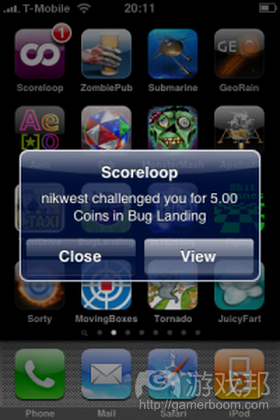
push notification from insidesocialgames.com
可使用“提醒”多少次?
3次内能够吸引玩家。通常每天3次就是极限。所以请合理使用。运用何种提醒通知以及其使用目的/时机是创造成功游戏机制的关键。那么什么情况才适合出现提醒通知?
* 消亡极限
* 时间极限
* 数量极限
* 新内容/功能
* 折扣
上述情况都是促使玩家重返游戏或推动游戏发展的绝佳时机。消亡、时间和数量极限与游戏情景或活动密切相关(游戏邦注:如耕作、烹饪和创建活动),是收获或完成某活动的时机。访问者通知则与免费增值游戏的社交元素密切相关,新内容和折扣活动会带动玩家,推动游戏进展。
篇目4,Matthew Tubergen谈推送信息的促销功能
何为促销提醒机制?
促销提醒是一个吸引用户重访游戏的好方法。开发者可针对多种商品推出优惠折扣,例如:
·虚拟货币折扣(例如,“仅限今日的货币包半价出售”)
·虚拟商品折扣(例如,“仅限今日的半价库存”)
·限时促销(例如,“仅限今日的半时收割活动”)
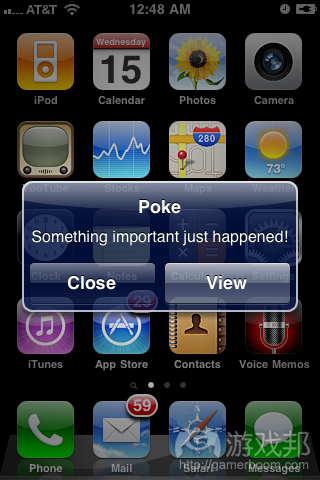
poke(from smartappmarketing)
使用提醒机制的时间和位置
我们之前的文章曾讨论过开发者发出推送通知的时间间隔问题,我们的经验表明,每天向用户发出推送通知的最大极限是3条信息。也就是说,每日促销提醒就要占用其中一条信息,所以开发者需制定周全的计划,以免让用户短时间内遭遇海量的信息。
至于开发者应何时“何地”向用户发送提醒,这要取决于不同的情况。
何时:这一点有赖于开发者的促销时间。如果促销时间越久,用户就会考虑更长时间才做出购买决定。需注意的是,创造一种紧迫感有利于加快用户做出消费决定,所以开发者必须在提醒信息中注明“仅限今日”或“限时折扣”等内容。
“何地”:开发者面临两种选择,一是在用户开启应用时或进入应用时就弹出推送信息,二是在用户开启应用前就弹出推送信息。开发者应视自己提供的优惠条件,选择合适的信息推送位置。
提醒机制必不可少
这一机制的作用不容小觑,你必须至少采用其中一种方案。提醒机制是促使免费增值游戏获得成功的必具要素。
篇目5,Brendan O’Kane谈适当推送消息可以提升沉浸感
最近,我读了一些关于手机应用分析的重要性的好文章。
那些文章主要是关于应用商店表现的评估,以及安装前和安装后数量的分析,我想介绍设计手机应用推广活动的另一个关键环节—-手机信息的评估。
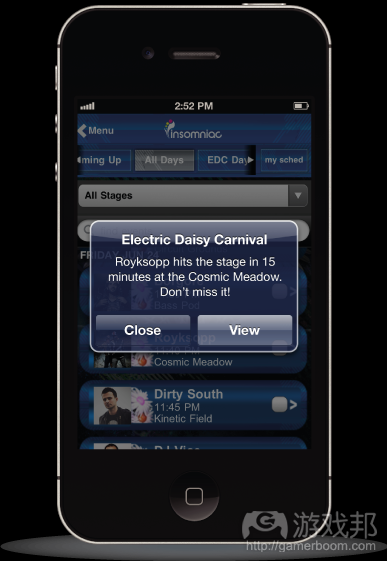
push-live-messages(from gamerboom.com)
“到设备”的推送提示和“在设备”的信息如应用内置的推送、警告和促销信息,已经成为游戏应用开发者和发行商对话消费者的最佳方式。
恰当使用的话,这些信息有助于保持玩家的沉浸感,从而提高玩家留存率,以及促进非付费玩家向付费玩家转化。
手机的普及导致手机市场营销活动的普及。然而,随着这些活动的成本上升,发行商必须寻找一个更好的方式来评估活动的效果,以便安排日渐上升的预算。到2016年,营销活动的预算可能达到每年370亿美元。
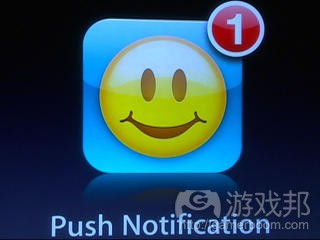
Push Message(from cnet)
假如,你正在通过应用内置提示推广新游戏,或任何其他类型的手机营销信息,评估就是最大化投入价值的关键。
增加价值
Forrester预测,到2016,手机商业—-包括手机游戏业,将以39%的复合年增长率发展,达到310亿美元的规模。这个数字不计算我在上面提到的市场营销/广告费用。
那意味着,通过设备达到消费者的市场营销信息的数量也将不断上涨。
然而,如果那些信息是无关的,不合宜的或数量过多,消费者可能不会阅读信息,或选择关闭该功能,甚至直接删除游戏。
手机的高度私人化性质要求信息必须能增加消费者寿命的价值。评估你的受众对作息的反应是估计那些信息的影响力的最佳办法。
玩家在自己的设备上玩游戏,这就产生了营销人员得以分析的数据,从而确定消费者个人的需求。
这使得那些营销人员制作这样一种即时而相关的信息。所谓即时,就是在玩家使用手机频繁时发送信息;而相关则能提高玩家转化率。
因为手机信息是受限的,所以你要想办法确保你的游戏提示增加了价值。
新关卡、技能树的提示、新拓展包的公告或升级所需的经验的提醒,对玩家来说都是重要的信息,很可能增加他们的游戏在线时间,如果没有干扰他们的游戏的话。
动作分析
通过分析工具,营销人员可以稳住玩家的心和钱包—-将他们作为可能尝试其他产品的消费者。以下是一些可执行的技巧,可以保证你的游戏信息达到理想的效果:
首先,你要收集行动分析数据—-即信息发送和打开、最后一次打开时间,以及打开的结果如注册、购买或分享(也就是将特定信息与用户的特定行为和结果关联起来)。
再者,你要做A/B分裂测试。你会使用你通过行动分析收集到的数据来制作一个营销信息的多个版本,然后发送给各类目标受众。
一旦结果出来,你就可以看到哪种用词、长度、语气和视觉元素带动更高的转化率,你就可以将其发送给所有目标受众。
最后,分裂测试之后,你要重新定位。使用你在这前两个步骤中获知的玩家信息,发送跟进信息给那些没有打开第一次信息的玩家,或打开了但没有转变的玩家。
这样,你就可以保证你的没有错过任何可能实现玩家转化的机会。
以Halfbrick为例,该工作室最近决定促进包括《Jetpack Joyride》和《Fruit Ninja》在内的多款热门应用的玩家沉浸感和收益情况。
我所在的公司OtherLevels最近正在A/B分裂测试Halfbrick发送给全球用户的推送提示(跨越24个时区和13种语言)。
它还测试了音调、用词和许多其他变量,以清楚地显示手机受众的需求。
饱和
随着移动设备的使用在全球日趋饱和,事实上手机已经无处不在了。不可避免地,手机意味无时不刻的游戏—-走着玩、车上玩、床上玩,甚至上厕所也玩。
这意味为了实现最高投资回报率,开发者和发行商必须从激烈的竞争中脱颖而出,夺取消费者最多的注意力。
采用行动分析技术,营销人员可以更加了解消费者,最终增加消费者的沉浸感,以及拉动应用的长期收益。
偏负面分析:
手机应用开发者滥用推送通知,这种现象必须予以制止。虽然普遍看法是,持续向用户发送非关键性更新内容不是有效策略,但应用开发者似乎很难抵挡此免费营销渠道——选择性推送。频繁的通知信息能够促使用户将应用放在心上,促使他们重新启动应用,查看新内容,适时提醒他们,甚至更多—–或者,至少这是应用开发者的期望。但有用/友善与永不停息的垃圾信息之间存在明显界限。
推送通知能够让社交应用看起来颇受欢迎,否则它可能没有展示的渠道。手机持续响起,以告知我们有多少用户正在查看新应用。但用户能够接受的展示内容有限度。
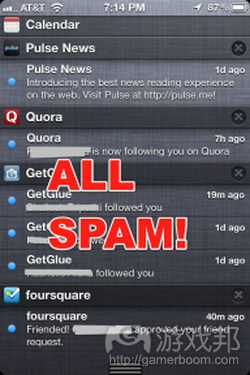
notifications iphone from techcrunch.com
关于某位好友订阅某服务,或发表评论,或“liked”某内容,或加你或关注你之类的通知鲜少是必要信息。这不是真实新闻。知道自己多一位粉丝并不会提高你的生活品质。这并不值得你将注意力从现实生活的手头工作转移,你的手头工作通常更加重要。虽然你也许会想要立即获得某些社交应用的相关信息,但你多半不希望在自己所安装的应用中被这些更新内容打断。
这只是一种类型,但社交应用通常是最严重的冒犯者。除社交类型外,还有很多各式各样的推送通知类型。查看如下列表:
娱乐
* 新内容(报道,专题)
* 时效性事件
* 日常专题(每日新闻)
出版业
*轰动新闻
* 本地通知
* 读者抽奖
* 服务信息
* 免费试用切换提示
* 订阅追加销售的单一版本
* 特别策划或问题聚焦
* 本地商业信息
媒体
* 新内容(完整事件、广告传单、奖励内容等)
* 提醒(表演事件、特别露面、现场事件)
* 投票(问题、提醒、结果)
* 将用户推向其他媒介(手机网站、电视节目)
零售业
* 征求产品评论
* 关于你综述及所追踪产品的评论
* 产品可用性/新风格
* 发货确认
* 订单查询期满
* 交易/产品销售
* 个人优惠券
* 建议
* 征求售后服务评论
* 发送品牌化娱乐/合作模式和顾客营销(视频和照片等)
* 基于本地数据的推送消息,如适合置身滑雪小镇用户的滑雪橇(游戏邦注:扩展至适合其他运动场所)。
社交网络
* 回应+所发布内容的反馈信息
* 用户互动
* 来自所追踪账号的新内容
* 功能更新
* 推进用户粘性的广播(新内容、你的内容得到推荐等)
B2B
* 新文章
* 即时支持
* 即时用户服务
上述内容中,有多少条你认为是关键信息?我想大概1个手指就能数完。即时这样,关于多久及何时看到这些内容,你依然有自己的若干限定标准。
推送通知滥用所存在的问题不仅仅在于,当你被毫无意义的内容打断时,你会感到非常恼怒,还包括用户将对整个推动消息机制本身产生怀疑。我想我们大概已心生怀疑。若应用初次询问是否发送推送通知时,你就予以否定回答,那么你基本就是持有此观点。用户不再相信开发者会合理运用机制,所以我们决定完全退出通知机制。
这非常遗憾,因为若把握得当,推送通知完全具有可行性。Urban Airship(游戏邦注:他们是通知功能提供商)表示,遵循“合理”通知消息规范的应用能够在内容下载后的6个月里将留存率提高1倍。“合理”推送通知的优点将与日俱增。合理推送通知能够在内容下载后的头一个月里将应用使用率提高67%,2个月和3个月期间分别能够提高74%和81%。
合理推送通知和用户具有高度关联性,着眼于满足需求。记住,是用户的需求,而不是应用开发者的需求。只有开发者,而不是用户才会关心应用的启动频率。Urban Airship首席营销官Brent Hieggelke表示,“很多时候,我们看到的是,推送通知只迎合应用或品牌目标,而非着眼于有意义的内容,这会很快流失用户。不要让推送通知打断他们的生活,因此你需要确保内容有价值。”
那么合理推送通知的具体例子有什么呢?他表示,Burton Snowboards就是个典型例子。他们通过向用户提供实时降雪量推送通知将用户同相关信息联系起来。其他公司则也许会采取不同策略,例如发送许多促销信息。这有可能会流失公司的忠实用户。Burton通过告知用户有用信息,树立自己的商誉及保持内容的相关性。
当然,最困难的部分在于,找出用户认为“合理”的内容,Burton Snowboards应用用户多半会关心实时预警。但每个用户都截然不同,从理想角度来说,他们应该在通知内容和通知频率上享有更多选择权。各应用的设置应融入相关控制装置。如果没有,那么开发者就会因为过于谨慎而犯错。毕竟,在界面上删除应用要比通过手机设备的深入开关设置操作简单许多。
篇目7,games谈推送的反社交问题
首先,我要声明我很喜欢社交游戏,他们因为无需付费,而且在游戏中还可以遇见各种不同的人。同样,我为社交游戏在过去的两年中的迅速发展表示高兴。
然而,在我FarmVille、Mafia Wars等社交游戏长达一年后的现在,我不得不提出自己对这类社交游戏的四点抱怨。
1,出错,出错,出错
我对社交游戏最大的不满在于游戏总是出错,譬如游戏道具无故消失、按键失效或游戏连接失败等问题时有出现。一旦某款游戏起个头,另外的很多问题就接踵而至。
例如这周末我在打理FarmVille的庄稼时,游戏突然跳出了一个“游戏服务中断”的信息框,这就意味着我不得不重新载入进度,将我刚刚完成的事情再做一次。因此,5分钟前我刚刚收获、种植的庄稼,我现在必须在重新收获、种植一次。
同样这种情况在Mafia Wars也有发生。尽管Zynga游戏开发公司一再承诺即将提供更稳定的游戏环境。但在这之后,Mafia Wars发布了一项特别任务San Juan,之后被公司收回然后又重新发布了一次。而在这之后的几星期又发生了类似的Beat the Feds时间。然后不久,FrontierVille也有一次类似的大规模重复载入。
也许有些人会说这是社交游戏的本质——游戏开发后不经测试就投入运营。但我希望有朝一日社交游戏的整体形式得到升级。毕竟将还存在许多问题的游戏投入市场并不是明智之举,尤其游戏开发商要考虑到这些间歇性问题有可能导致玩家的直接经济损失。
2,烦人的弹出广告
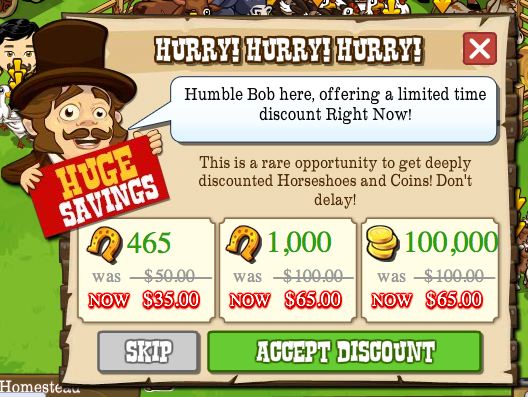
Frontierville Discounts(from gamerboom.com)
我注意到最近很多游戏都引入了任意弹出窗口来通知玩家各种游戏虚拟货币促销活动。这像极了夜间时段那些愚蠢的电视直销节目。我既不需要Slap Chop也不需要Perfect Fit按键,我更不想买FrontierVille的马蹄铁。除非游戏推出一个2.5折清仓大甩卖我才可能在游戏中花点现实货币。除此之外,我不考虑购买任何游戏道具。现在Zynga旗下的多款游戏都很盛行这种广告方式,但这对我无效。
另外,弹出窗口也是一件烦人的事情。我既然已经同意游戏在我的墙上发帖了,为什么我还必须点击那些请求在我的Facebook墙上发帖的弹出窗口呢?
3,游戏中要做很多额外的任务
在社交网站Facebook上玩游戏的一个优点就是节省时间,我可以忙中偷闲,玩个5分钟游戏。一开始,FarmVille等热门Facebook游戏的任务很快就能完成。而一般玩家升级到最高后,游戏也就结束了。但是,为了让玩家继续玩游戏,游戏开发商们发布了一个又一个的新功能——特别战斗事件、可建造的道具、节日活动等等。尽管这些新增功能的确让玩家忙碌了起来,但它们也同时强迫玩家完成过多的任务。
Zynga公司的Treasure Isle可谓是其中最糟糕的一款。在这个游戏中,我曾经同时进行4项任务。然而为了这款游戏,我并不是在挖宝,而要花费所有的时间在Facebook墙上发帖,请求朋友送我染料、绳子或其他任务道具。另外,RockYou公司的Zoo World也是一样。
4,花费几个小时“接受礼物”
赠送和接受礼物是社交游戏的主要组成部分。我喜欢收到礼物,Pet Society, Cafe World和PetVille等几款游戏的确发布了很棒的送礼进程。但是在我最经常玩的三款游戏(FarmVille, FrontierVille和Mafia Wars)中接受礼物却很耗时。
整个接受礼品的流程如下:在Facebook点击接受礼物,稍等片刻后我进入了游戏界面,然后点击确认接受礼物,最后再点击回到Facebook游戏礼品页面(如果还打得开的话)。
有时我会接受别人的赠礼,但那时页面不会直接进入Facebook,而是游戏会自动读取。然后我不得不狂按返回键以免读取游戏的时候被卡住。
尽管知道开发公司这样设计送礼步骤有一定的理由,但我衷心希望可以有更简捷的方式。我不想点击任何按键——只要将页面自动转换到礼品盒,让我节省接受礼物的时间,投入更多到玩游戏中。
(本文由游戏邦编译,转载请注明来源,或咨询微信zhengjintiao)
篇目1,6 Tips For Effective Push Notifications
by Evan Fradley-Pereira
There’s a fine line between a helpful reminder and an annoyance, and your game’s push notifications have the potential to register as either. That said, there are plenty of players who look forward to hearing from their favorite games because their publishers have taken to the time to learn what their players want and when they want it. Here are a few tips to help make sure your players look forward to hearing from you.
1. Know How and When to Ask Permission
All games need permission from the player before they’re allowed to send push notifications. When the user agrees to the request, a token is supplied which allows the game to contact the player in future. Few games time their push token request properly. Most drop it in at the start of the very first session, when the player’s knowledge of the game is limited to its name, icon, and whatever they may have read in the store description. Active players get bombarded with these requests and the majority of the time, it’s not a great experience. Many publishers take a shotgun-approach to notification delivery that not only hurts performance in their game, but in all games that rely on push notifications to communicate with their players.
To stand out, wait until your players have had a chance to play the game before you ask, and contextualize the request so that players know what they’re signing up for.
Crossy Road does this perfectly. Instead of requesting permission on start up, they wait until the player has had a chance to associate the fun of unboxing new characters with receiving free gifts. As soon as they’ve opened their second character, the game asks if they’d like to be reminded when the next gift is available. Agreeing prompts the token request and players can make the decision with the understanding that they’ll be contacted when the next bit of fun is available.
2. Get Specific
From the outset, think about why you’re contacting your players and decide exactly what you want them to do when they receive the notification. Do you want them to complete a purchase? Is there a specific mechanic you want them to engage with? Knowing the answers to these questions will help you measure the effectiveness of your promotions and write effective copy.
3. Know Your Audience
Having a thoroughly segmented player base is half the battle when it comes to running effective push campaigns. The more certain you can be that you’re talking to the right players about the right offers, the more successful your campaigns will be.
Don’t message non-converted players with offers for $50 IAPs. It’s extremely unlikely that any player’s first IAP would be so high-priced, and you’re demonstrating a lack of understanding for their play style. Likewise, don’t reach out to your whales with discounts on small IAPs that wouldn’t be of any use to them. Over time, these kinds of nuisances can cause what would have otherwise been an engaged, attentive player to deactivate your game’s notifications.
4. Get the Timing Right
In order to capture as much attention as possible, time your push notifications to coincide with hourly spikes in session counts. Sessions are typically highest in the mid-afternoon on weekdays and in the evenings on weekends, but always check your analytics to see what time is most popular for your players. Games geared towards younger audiences are often most active around 3PM to 5PM, during the after-school commute. This ensures that a good chunk of your players will receive the notification around the time that they would typically engage with your game anyway.
5. Omit Needless Words
Notifications get truncated around 110 characters, or roughly 4 lines of text, so make sure you get the important details included up front. The shorter you can make your notifications, the easier it is for players to scan during moments when their attention is elsewhere. Longer notifications risk not getting the message across and can result in fewer engagements.
6. Provide Details
As mentioned in one of our recent posts on Gamasutra, the players who complete an IAP will only ever be a subset of those who are made aware of the option. In between awareness and completion, players need to evaluate whether the offer is of value to them. Your notification copy can help.
“Come on back! We’ve got a great offer for you!”
Notifications like these don’t provide the player with the information necessary to immediately evaluate the offer. It baits them into returning to the game before they can get the details, which can end up feeling like a waste of their time if it turns out it’s not for them.
Instead of giving your player more work to do, include all the details of the offer directly within the notification. Shoot for notifications like:
“Big Bags of Coins are 50% off this weekend only! Buy Now!”
They give your players everything they need to decide whether or not they want what you’re offering the moment they read it. They might feel pushy, but if you’re segmenting effectively and only delivering relevant offers to the appropriate players, you’ll be doing them a favor.
Targeted push notifications are just one of the tools we provide at Fuse as part of our complete Player-Centric Platform. Our goal is to help our partners maximize revenue by giving every player an optimal experience. I’m always curious to hear what sorts of push notifications have worked best for others, so as always, feel free to get in touch with me on Twitter.
篇目2,Show and Tell – Feedback and Notifications for Mobile Games
by Thais Weiller
I sometimes have dreams in which I do every day stuff such as frying an egg. However, sometimes in these dreams I do these things exactly like real life and they turn out a complete failure out of nowhere so I have absolutely no idea what went wrong. Does that happens to you too? Pretty sure it happened at least once. So there is me, frying the above cited egg and then all of suddenly the egg is actually a tiny colorful bird and I’m a sadistic psycho torturing the poor animal and get arrested for this.
But how could I know? That egg was just like any other real life egg! Turns out that our subconscious is a really bad game designer which doesn’t give you the right info before you make decisions. This makes you feel that you were cheated by your own mind. That’s ok on a subconscious since people cannot purchase new ones, but you don’t want to recreate this effect on a game, otherwise player will feel cheated and will surely switch to another game.
Feedback is the most effective way player will receive information about the game and that’s why it is so important on a game. There are two main kinds of feedback, immediate and long-term feedback. Immediate is mostly gameplay oriented and helps player to understand what actions to perform [attacking, jumping], which not to [falling into a cliff, running into an enemy], and what his general status in the game.
Gimme!
For instance, when Mario get a coin we hear that well known pleasant sound and a small number starts to rise, when he touches that brown mushroom-like thing (a.k.a. Goomba) a not so pleasant sound rings and he shrinks. It’s pretty clear what player should try to achieve and what must be avoided.
Angry Birds has numbered stages and different worlds, which provide player feedback of her progress and gives a sense of accomplishment.
As important as immediate feedback, long-term feedback is that pat in the player’s back that says “Hey, look how far you got! Congrats, man”. Classic games generally used to “pat” by using environmental changes [such as Egypt and Lava stages which basically said “these stages are different and BADASS, great progress”] and by introducing new mechanics and enemies. Though this is still used nowadays, there are other more effective ways to make player’s progress more overt.
Candy Crush Saga map has the same function of Angry Birds’ stages but also is designed in a more playful way.
But sometimes, your player just won’t be in the game so that we can get feedback long-term. This is especially common on mobile since player can, at any given time, receive an email notification or something of the sort and deviate from the game, never to remember to get back. On mobile, we can use notifications for the “Oh right, I need to get back to this awesome game” effect and that’s why they are indispensable. But you can’t just add notifications and hope for the best without taking in consideration the notifications style best matches the kind of game you are doing.
For instance, games that are based on real world time, as Tiny Tower or D.O.T, generally notify player the exact moment we has something new in the game, but don’t notify anything else after. Tiny Tower always notifies the first floor that need to be restocked after player leaves, but not the subsequent ones, while D.O.T notifies when player’s energy is replenished. This “first event to happen and only” is important because if notification is used too frequently, player may get annoyed and uninstall the game.
Tiny Tower uses notifications elegantly
Not real time based games have a more difficult time in choosing the right cue to notify. Notifing too much for the wrong things will make the app look like a spam factory and notify too little may make it dive into the oblivium. One cool thing to do in this situation is to create an event agenda that periodically changes gameplay or items. For instance, each week your infinite runner has a set of different items that are randomly spawned in the level design and player can collect them, it’s cool to notify player every time a new collection is available.
Of course, notifications won’t drive your player back to the game if you don’t have such a good game to start with, they are important but not magical. Used with good sense and in the context of the game, notifications can help your game shine.
篇目3,Mastering Freemium Game Mechanics: When and why to use alerts
by SmartApp Marketing
It’s the scenario every app gamer dreads, at least those of use that reach for our phone first chance we have a free moment. You’ve been in meetings all day, you’ve felt your phone buzzing, unable to be checked. How many emails and texts and calls have you missed? You finally get a chance to peak at your phone. You pause in disgust briefly before throwing your phone across the room after tapping with 4 dozen push notifications for everything from rotting crops to the tenth “deal of the day”.
Alerts and push notification are powerful mechanisms for engaging users and driving freemium game success, but wielded incorrectly they can destroy your chances. In this week’s Mastering Freemium Game Mechanics we’ll examine different kinds of push notifications and appropriate use, in coming weeks we’ll dig deeper into wielding some of these tools.
Freemium Game Development: How Many Times Can I “PUSH”?
The third time is the charm. Generally speaking more than three push notifications a day is pushing, no pun intended, the limit. So use them wisely. What kind of push notification and why/when you use it are key to successful gaming mechanics. So what events are susccessful as a push notification?
* Decay Thresholds
* Time Thresholds
* Maximum Thresholds
* Visitors
* New Content/Features
* Discounting
All of the above offer key opportunities to either drive users back into your app or encourage game progression. Decay , time and maximum thresholds all should be familiar from the post on reward schedules. These thresholds are tied to events or actions within the game think: farming, cooking, and building be it time to harvest or completion of an action (building). Visitor alerts tie to social elements of freemium games while new content and discounting drive action and game progression. Next week we’ll explore the thresholds deeper.
Do you have other key opportunities to utilize alerts that you’ve identified in your games? Sound off below.
Matthew Tubergen, Product Manager, Recharge Studios, W3i, LLC
Matt is a mobile content expert with a decade of experience working with brands that include Disney, NFL and LucasArts. Matt heads up W3i’s wholly owned publishing arm and investment fund, Recharge Studios
篇目4,Mastering Freemium Game Mechanics Series: Discounting Alerts
Published in syndication with Mobile Orchard.
What are discounting alerts?
Discounting alerts are an outstanding way to drive users back into a game, or entice them while already there. There are a variety of things that can be discounted and potentially trigger an alert, for example:
Virtual Currency Discounts ( ex. “Receive half off all bundles of dolphin bucks today only)
Virtual Good Discounts ( ex. “Today only build stockpiles for half off”)
Time Discounts (ex. “Today only harvest in half the time”)
When and how often to use alerts.
In our post on when to use alerts we discussed how far a developer can push, the use of push notifications. Our experience has been that three notifications a day is a maximum threshold. With that understanding daily discounts would eat up one of your three potential alerts. A schedule of alerts would be beneficial to ensure you don’t inundate your users with notifications about: free this, rotting that and visits from so-and-so.
Under that premise, the question of when or where can result in a couple different scenarios.
Regarding when, it depends on the timeliness of your promotion. The reasoning here is the longer a consumer has to consider the offer the bigger window of time to make a decision. Additionally, a sense of urgency helps speed that decision process. Messages such as “Today Only” and “For a Limited Time” are musts in your alerts.
Regarding where, you’re faced with two options: a notification upon opening an app or within the app (local), and a notification that pre-empts the opening of an app (push). Depending on the offer, it may be large enough of a carrot to push a notification and drive a user back into the app.
Alerts are a must.
Whatever you decide that works best in your schedule, make sure you have one. Alerts are an absolute must in driving the success of your freemium games. Next week we’ll examine threshold alerts. Do you have a question about freemium gaming or a topic you’d like us to explore? Let us know in the comments or catch us on twitter @rechargestudios or @w3i.
Matthew Tubergen, Product Manager, Recharge Studios, W3i, LLC
Matt is a mobile content expert with a decade of experience working with brands that include Disney, NFL and LucasArts. Matt heads up W3i’s wholly owned publishing arm and investment fund, Recharge Studios
篇目5,How proper push messaging can keep your players engaged
by Brendan O’Kane
Brendan O’Kane is the CEO of messaging analytics vendor OtherLevels, and has over 20 years of experience in the mobile ecosystem.
He managed global accounts such as the Cable and Wireless group for Oracle Corporation, before growing Oracle’s Asia/Pacific services offering to a $150m business.
He subsequently led a US mobile messaging business in Asia/Pacific prior to its acquisition in 2001. In the past decade he has been an active investor and director in mobile and on-line properties.
Recently I’ve read some great PocketGamer.biz pieces on the importance of mobile app analytics.
While these articles focused on important app store performance measurement, as well as analysis of both pre- and post-install numbers, I wanted to introduce another critical component for devising a common-sense app-based mobile campaign – the measurement of mobile messaging.
‘To-device’ push notifications and ‘on-device’ messaging such as in-app pushes, alerts and promotions, have grown to be among the best ways game app developers and publishers can speak to customers.
Used correctly, these messaging formats can help engage and retain those customers as well as drive conversions.
The proliferation of mobile has, in turn, led to a proliferation of mobile marketing campaigns. However, as spending on those campaigns grows, publishers need a better way of measuring campaign performance in order to justify their growing budgets. They’re expected to reach a yearly $37 billion by 2016.
If you’re sending, say, in-app alerts to promote a new title, or any other kind of mobile marketing messages, measurement is the key to get the most out of what you’ve spent on them.
Adding value
Forrester has predicted that, by 2016, mobile commerce – including the mobile gaming industry – will have grown by a compound annual growth rate of 39 percent to become a $31 billion business. And that’s without counting the marketing/ad spend figures I mentioned above.
That means ever-growing numbers of marketing messages reaching consumers on their devices.
However, if those messages are irrelevant, untimely or excessive, they’re more likely to turn customers off, possibly leading them to disable messaging or delete a game altogether.
Mobile’s highly personal nature demands messaging that adds value to customers’ lives. Measuring your audience’s response to your messages is the best way to gauge those messages’ impact.
As gamers play on their devices, they create data that marketers can analyse to get a clear and detailed picture of an individuals’ wants and needs.
This allows those marketers to craft messaging that is both timely – delivered at a time when the customer is active on mobile – and relevant, which increases the likelihood of a conversion.
Understanding that mobile messaging is limited, take the steps to make sure your game’s notifications add value.
Reminders of new levels, new perks for a skill tree, announcements of new expansion packs or of enough XPs required to reach a new level are examples of things that matter to gamers and are likely to increase play session times. Bonus if you do not interrupt their game play!
Action analytics
Through analytics tools, marketers can secure a valuable foothold in gamers’ minds, hearts and wallets – and retain them as customers who will likely try other titles in the library. Here are some actionable techniques to ensure your games’ messages are driving desired outcomes:
First you’d collect action analytics data – e.g., messages sent vs. opened, time since last open, and opens resulting in goals such as registrations, purchases or social shares – that links specific message copy to particular user behaviors and outcomes.
Next, you would A/B split test. You’d use the data you gathered through action analytics to create multiple versions of one marketing message, which you would send out to significant samples of the audience segment you’re targeting.
Once the results come in and you can see which wording, length, tone and visual elements drove higher conversions, you send them out to your whole target audience.
Finally, after the split tests, you would retarget – which boils down to well-informed persistence. Using what you’ve learned about your gamers during the previous two steps, you send follow-up messages to those who didn’t open your first message at all or who opened it but didn’t convert.
This way, you can make sure you haven’t missed any opportunity to get the kind of conversion you want.
Halfbrick Studios, for example, recently decided it wanted to boost engagement and monetisation opportunities within its many popular apps, which include Jetpack Joyride and Fruit Ninja.
OtherLevels is currently A/B split testing the push notifications Halfbrick sends to its massive global customer base, which is spread across 24 time zones and speaks 13 languages.
It’s also testing for tonality, word choice and many other variables to create a full picture of the mobile audience.
Saturated
As adoption of mobile devices continues its march toward global saturation, there’s practically no place left where mobile devices won’t be present. Inevitably, mobile means gaming, with consumers playing on the go, on the couch, in bed and even on the toilet.
That means developers and publishers seeking top ROI will need a way to stand out from the pack and hold consumers’ attention.
By implementing action analytics techniques, these marketers can make sure they’re learning more about their customers with each and every interaction – driving engagement and monetisation opportunities for the long haul.
篇目7,App Developers: Stop Abusing Push!
By Sarah Perez
Mobile app developers are abusing push notifications and it has to stop. Although it’s widely understood that it’s not an effective strategy to continually ping users with non-critical updates, app developers can’t seem to help themselves to the free marketing channel that is the opt-in push. Continual notifications keep the app at the forefront of users’ minds, entice them to relaunch the app to see what’s new, remind them of something they may have forgotten, and more – or, at least, so the app developer hopes. But it’s a fine line between being seen as useful and friendly versus a source of never-ending message spam.
Push notifications can give a social app an air of popularity it wouldn’t otherwise have the means to display. The phone continually buzzes to indicate how many people are checking out the new app. But there’s only so much showing off a user can take.
Notification that a friend of yours signed up for the service, or left a comment, or “liked” something, or added you or followed you, etc. is very rarely must-have information. It’s not actual news. It doesn’t improve your life to know you have one more follower. It doesn’t deserve the right to pull your attention away from whatever you were doing out there in the real world, which is almost always far more important. While there may be the rare social app where you want to know these things immediately (Facebook perhaps?), in all likelihood, you don’t want to be interrupted with these sorts of updates for every app you install.
That’s just one genre, but social apps are often the worst offender. Beyond social, there are all sorts of push notification types out there. See this list courtesy of Urban Airship:
Entertainment
* New content (items, features)
* Time-sensitive events
* Routine features (word of the day)
Publishing
* Breaking news
* Local alerts
* Reader sweepstakes
* Service messages
* Free trial conversion prompts
* Single-edition to subscription upselling
* Special section or issue highlights
* Local offers
Media
* New content (full episodes, teasers, bonus content etc.)
* Reminders (show times, special appearances, live events)
* Polling (Questions, reminders, results)
* Drive users to other media (mobile site, television program)
Retail
* Ask for Product reviews
* Comments on your reviews and the products you follow
* Product availability/new styles
* Shipping confirmation
* Shipping updates
* Shopping cart expiration
* Deals/sales
* Personal coupons
* Recommendations
* Ask for customer service reviews
* Send branded entertainment/co-op and shopper marketing (video, picture, etc.)
* Push based on location data ie ski gear to people who have been in ski town zip codes ( expand to fit additional sports locations)
Social Networking
* Responses + feedback on posted content
* User interactions
* New content from followed accounts
* Feature updates
* Broadcasts encouraging engagement (new contest, your content has been featured, etc.)
B2B
* New articles
* Real-time support
* Real-time customer service
How many of those items above do you actually think are critical messages? I’ll bet you can count them on one hand. And even then, I’ll bet you have a few qualifiers about how often and when you want to see them.
The problem with push notification abuse is not just that it’s annoying when you’re interrupted by something that has no meaning to you, it’s that it creates an environment where users become suspect of the whole push notification mechanism itself. I’d argue we’re already there. If you’ve said “no” to an app upon first launch when it asks your permission to send push notifications, then you basically agree. Users can no longer trust developers to use the system properly, so we’re opting out of notifications entirely.
That’s a shame because when done well, push notifications can and do work. Urban Airship says that apps following “good” push notification practices can actually more than double the retention rate over a six-month period after download. And the benefits of “good” push grows over time. Good push notifications drive 67% of app usage the first month after download, 74% of usage two months after download, and 81% of usage three months after download, they found.
Good push notifications, in case you’re wondering, are those that are highly relevant to the user and focused on meeting their needs. Remember, that’s the user’s needs, not the app developers’ wants. Only developers care about how often an app is launched, not the user. “We’ve seen time and time again, push notifications that solely serve an app’s or brand’s objectives rather than what is really meaningful can turn people off fast,” said Brent Hieggelke, CMO, Urban Airship. “It has to pass the family dinner test. Push interrupts their lives, so you have to make it worth it.”
So what is a an example of a good push notification? Burton Snowboards is a perfect example, he said. They found a way to engage users with relevant information by offering to push fresh snowfall alerts to customers. Another company might have taken a different approach, like sending a ton of promotional sale messages. This would risk alienating the company’s best customers (“Hey, I already bought the snowboard! Give it a break!”) Instead, Burton builds goodwill and stays relevant by telling customers something useful.
Of course, the hard part is figuring out what a user considers “good.” Seemingly, a Burton Snowboards app user probably does care about fresh powder alerts. But every user is different, and ideally, they should be given more of a choice about what and how often you ping them. There should be controls in every app’s settings for this. And if there’s not, then developers should definitely err on the side of caution here. After all, it’s a lot easier to X an app from the homescreen than it is to toggle a switch deep in the phone’s settings somewhere.
篇目7,For the record, I love social games. I love that they’re free to play and accessible to all types of people. I love that their popularity has exploded over the past two years, and that they’ve been turning all of game-dom on its head.
But, after playing FarmVille, Mafia Wars and the rest for just over a year now, there are a few things in these games that have really started to gnaw on my nerves — four in particular. They don’t actually make me want to chop down a door with an axe like Jack Nicholson in The Shining, but they make me go, ya know, something, something.
Bugs, bugs, bugs
My biggest gripe about social gaming is the bugs. I’m talking about all of the little glitches in games that never really seem to go away. Examples of this include items that mysteriously disappear, buttons that don’t work or losing connection to a game. It’s like Whack-A-Mole, once one bug is bopped in the head, another one pops up somewhere else.
For instance, I was tending my FarmVille crops this weekend and got the ever annoying ‘Game out of sync with server’ message, which means you have to reload the game and re-do everything you just did again. So after spending five minutes harvesting and planting crops, then I had to do it again. Then I had to reload the game again. Then harvest the same crops again. Ugh.
This has happened to me several times in Mafia Wars as well. After promising that a more stable game experience was on its way, Mafia Wars rolled out a special event, San Juan, and then had to roll it back again. Then it launched again. This had also happened a few weeks before with the similar Beat the Feds event. FrontierVille, lately, has also been a big reloader.
Some might say that’s the nature of social gaming — everything’s created and pushed out to players without proper testing, but I’m looking forward to the day that this whole form of gaming evolves and it will not be acceptable for games to have so many problems after it’s made public, especially considering how many players might be losing real-life money due to some random in-game hiccup.
Annoying pop-ups advertising virtual currency sales
I’ve also recently noticed that more games have started introducing random pop-ups, informing me that I’ve been especially been chosen to participate in a sale on the game’s virtual currency. It’s all very annoying, kind of like those silly TV infomercials that play on a loop after midnight. No, I don’t want a Slap Chop or a Perfect Fit button, and I don’t want to buy any Horseshoes in FrontierVille either. The only way that I’m might possibly consider spending my real-life cash for virtual cash is if there was a 75% clearance sale. And that’s just to consider it. Zynga games have particularly been aggressive with this form of advertising, and it ain’t working for me.
Pop-ups in general are also annoying. If I have already given blanket consent for a game to post messages to my Wall, why do I still have to click on pop-ups that ask for my permission to post something to my Facebook wall?
Too many extra things to do in a game
One of the great things about playing games on Facebook is that you can get in and out quickly. I can take a break from writing or whatever I’m doing, jump into a game for five minutes, play and then be done. In the beginning, it was easy to run out of things to do in FarmVille and the other big Facebook games. Once you reached the max level, it was pretty much game over. To keep people playing, developers responded by rolling out more and more new features — special fighting events, buildable items, holiday-themed events, etc. While these new add-ons will certainly keep the average virtual farmer busy, they have also started to pull players into too many directions, rather than giving players a more directed experience.
Zynga’s Treasure Isle is one of the worst offenders — I am literally working on four side projects at once, and instead of digging for treasure, I usually spend most of my time posting message on my Facebook Wall, begging for friends to send me dye, ropes and other building materials to get the jobs done. RockYou’s Zoo World is another serious offender. Just slow down on the projects, partner. Not everyone is playing your game 24/7.
Accepting gifts … for hours
Sending and receiving gifts is an integral part of the social game experience. And let me tell you, I like getting gifts, however, accepting them. A few games like Pet Society, Cafe World and PetVille have streamlined the gifting process quite nicely. But, when it comes to accepting gifts in the three games I probably play the most — FarmVille, FrontierVille and Mafia Wars — it’s a time-consuming affair.
The process breaks down like this: I click to accept a gift on Facebook, then I wait while I’m bounced to the game. Then, I click another button confirming that I want to accept the gift. Then I click another button to go back to my Facebook game gift page (if available). Sometimes I’ll accept a gift from someone and instead of directing me back to Facebook, the game loads automatically right afterward. Then I’m frantically scrambling to hit the back button so I don’t get stuck waiting for the game to load. Exhausted yet? I am.
While I’m sure there’s a reason the gifting is set up this way; I really wish there was a better way to get the job done. I don’t want to click anything to receive gifts — just let them flow automatically into some virtual gifting box and let me have those hours I spend accepting gifts every week back to actually spend more time playing the games.
下一篇:如何有效管理一支2D图像创造团队







































 闽公网安备35020302001549号
闽公网安备35020302001549号